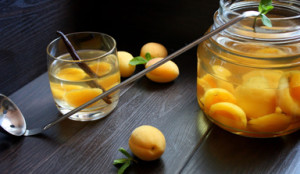 I don't think there's a home, which would not prepare preserves for the winter! And every year though, when tired of standing over the kitchen for several hours, we promise, that never again…, that last time…, with the advent of summer, we roll up our sleeves and change clothes, we choose, we cook, we pasteurize, fry – that is, we process.
I don't think there's a home, which would not prepare preserves for the winter! And every year though, when tired of standing over the kitchen for several hours, we promise, that never again…, that last time…, with the advent of summer, we roll up our sleeves and change clothes, we choose, we cook, we pasteurize, fry – that is, we process.
Raw materials are the most important. They must be of the highest quality. Is not truth, that e.g.. jam, jams or marmalades can be made from fruit of the second type! Likewise, you can not make sweet compotes from unripe apples.
If we do not have our own plot, we buy raw materials for preserves on the tarag, we advise you not to take all the quantity we need from one seller! If it turns out, that the fruit was not the best, we will avoid wasting all preserves.
Money is also important, which we have to spend on preparing homemade preserves. it is true, that a one-time purchase of products is a large expense, especially then, when we don't have our own plot, but nothing can replace the aromas and flavors of home-made products.
Processing fruit and vegetables does not require any specific "tooling."”. Utensils are used, which are used every day. Before starting work, however, it is worth gathering them in one place and examining them carefully.
Will be needed:
• bowls of various sizes. If we use metal, cannot be padded! The bowls are used for picking and washing the fruit. When we prepare juices, you can sprinkle fruit with sugar in them;
• wide, a flat pot with a thick bottom for the preparation of jams and preserves. A cast iron saucepan with a diameter of at least is best 40 cm, but enamel will also be good, as long as not padded;
• various types of strainers for draining fruit, fine sieves for chafing;
• self-adhesive jar labels to write the date;
• wooden spoons of various sizes for mixing preserves, vase spoons for putting them in jars;
• a stainless needle or a skewer for pricking the fruit;
• juicer, when we have our own plot, lots of fruit and we like juices. Admittedly, the expense is considerable, but it will pay off very quickly;
• paver – for amateurs of cherry preserves. Thanks to this device, we can remove the seeds faster and we will not get our hands dirty;
• scales and graduated vessels for measuring the amount of ingredients.
How to close jars and bottles?
Twisty caps must not be damaged. If the preserves are pasteurized, Put the fruit jars into the water undoed. We close them carefully after taking them out of the water. If we choose cellophane, the jars are boiled open (the water should be as high as 2/3 their heights, but it should not boil too much). After the end of cooking, the jars should be quickly removed and put on top of the cellophane moistened with boiled water or vodka. It should stick to the edges of the rings.
We can close the bottles with teats. The bottles must not be completely filled with juice, you have to leave free space, ok. 1,5 cm. The nipple will "retract."” inside the bottle.
Processing methods.
Pasteurization. Fast, tania, Okay (from the point of view of the principles of rational nutrition) and a permanent method. It consists in cooking tightly closed dishes filled with fruit or vegetables. The effectiveness of pasteurization and the good quality of preserves depends primarily on keeping the utensils and tools clean, as well as on the fruit and vegetables themselves used in preserves.. Thus, all utensils and tools must be thoroughly washed in hot water with the addition of liquid or powder, twice rinsed, then roasted in the oven or boiled. Place the roasting utensils on the baking sheet, put in a cold oven, heat it to temperature 100 degrees and hold for approx. 5 min. You can also boil the dishes: put into a large pot of water and cook 5 min. Use wooden tongs to remove clean jars.
Zagęszczanie. It is used for making jam, marble, jams. It consists in removing water by evaporation. However, this method of processing deprives the fruit of a lot of vitamin C..
Fixing with sugar. The method is quite expensive. Preparations preserved with sugar (soki, purees) they do not deteriorate with the content 70 proc. sugar.
Fixing with vinegar. Spicy pickles are harmful! The concentration of vinegar in the preserves should not exceed 2 percent. The vegetables acidified in this way are then pasteurized.
Souring. The method is popular, but quite difficult. It requires great accuracy and precision. Poorly washed dishes, not quite strict arrangement of products or insufficient shut-off of air access may cause, that the leaven will go bad quickly.
Drying. Droughts retain concentrated minerals, sugars and acids. However, they lose a lot of vitamins, therefore this method is used very rarely.